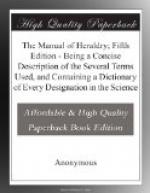[Illustration]
ESCUTCHEON OF PRETENCE. A small escutcheon, on which a man bears the coat of arms of his wife, being an heiress. See p. 40. [CHAP. VI.]
[Illustration: Ex. Argent, a chevron or, between three crosslets sable, on the fess point surtout the chevron an escutcheon of pretence gules, three quatrefoils argent.]
ESQUIRE. The degree below a knight and above a gentleman. Those to whom this title is due by right, are all the younger sons of noblemen and their heirs male for ever, the four esquires of the king’s body, the eldest sons of baronets, of all knights and of their heirs male: those who bear superior offices, as magistrates, high sheriffs, mayors, and aldermen, have it during their continuance in office and no longer. For the helmet of an esquire, see page 84.
[Illustration: Etoile.]
ETOILE. The French word for a star. It differs from the mullet in the number of points, and four of the points being rayant.
FESS. An honourable ordinary occupying the third part of the shield between the centre and the base.
[Illustration: Fess]
Ex. Argent, a fess gules.
[Illustration: Fess Point.]
FESS POINT. The exact centre of the escutcheon, as seen in the annexed example. See the escutcheon lettered at p. 6., where this point is marked with the letter E. [CHAP. II.]
FIELD. The whole surface of the shield or escutcheon: it is the ground upon which the colours, tinctures, furs, ordinaries, and charges, are represented.
FIGURED. Those bearings which are depicted with a human face, are said to be figured.
[Illustration: Figured]
Ex. Gules, three bezants figured.
FILLET. The only diminutive belonging to the chief; its width is one-fourth of the chief, and is always placed at the base of it. See CHIEF, p. 18. [CHAP. IV.]
FIMBRIATED. An ordinary having a border of a different tincture is said to be fimbriated.
[Illustration: Fimbriated]
Ex. Azure, a bend gules, fimbriated argent.
FITCHY. Is from the French word fiche, fixed. It is generally applied to crosses which have their lower branch pointed, so that it could be fixed in the ground. See CROSS FITCHY.
FLANCHES. Are formed of two curved lines placed opposite each other.
[Illustration: Flanche]
Ex. Azure, a flanche argent.
FLANK. That part of an escutcheon between the chief and the base.
[Illustration: Flank]
Ex. Argent, three mullets gules, accompanied with seven cross crosslets fitchy sable—three in chief, one in fess, two in flanks, one in base.
FLASQUES. A subordinate ordinary formed by curved lines placed opposite each other, but not so near as in flanches.
[Illustration: Flasque]
Ex. Azure, a flasque argent.
[Illustration: Fleur-de-lis.]




